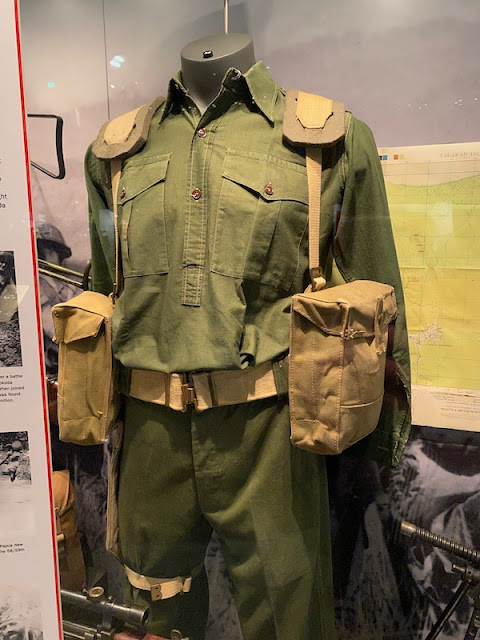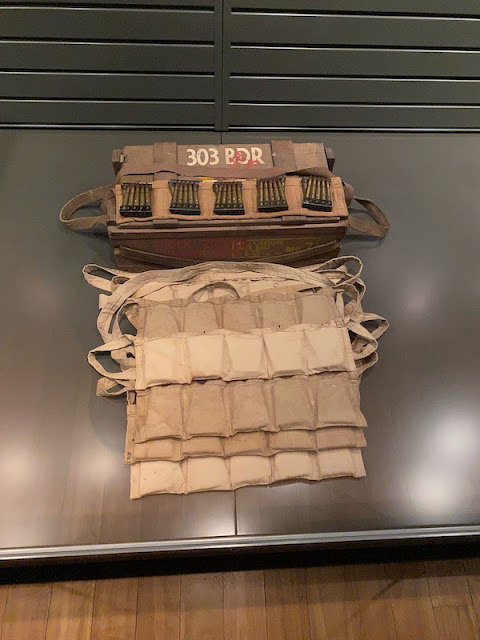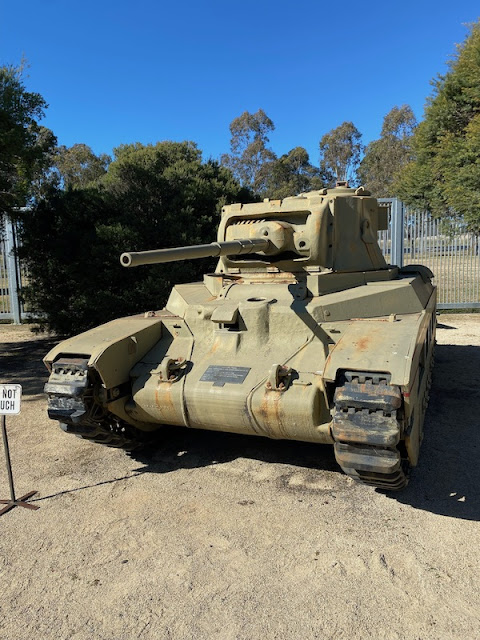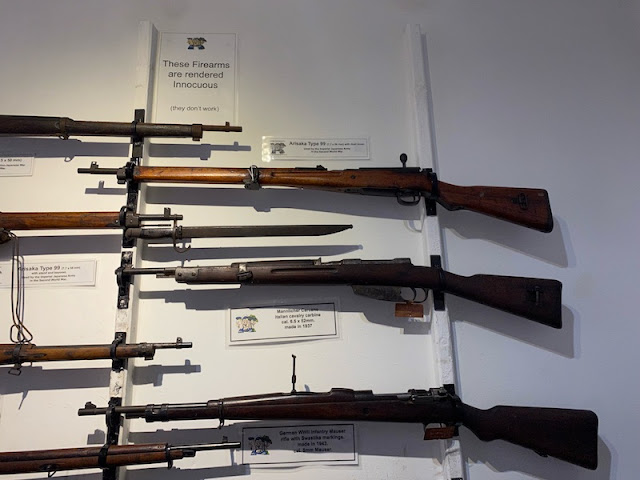The Australian Army Infantry Museum is a modest sized museum located in the military base outside Singleton in NSW. Originally established here as the Infantry Centre in 1973 the museum is now housed in a new, purpose-built building that opened as the Infantry Museum in 2014.

As the Sudan is a topic of interest it was good to see a small number of exhibits related to the involvement of the New South Wales contingent in the campaign (the first time soldiers from Australia had fought overseas).
The display covers Sudan and the Boer War. It includes two rifles, the one on the right is the familiar Lee Enfield MkI that was used by Australians in the Boer War. More unusual is the one on the left, the Alexander Henry rifle 1871. Of British origin it was used by NSW infantry from 1872 to 1885 and carried in the Sudan campaign.
One of the highlights was seeing a Nordenfelt and Gatling gun, both weapons I had never seen before. These were used by colonial forces within Australia, the Gatling being mounted on a ship in the naval force of the colony of South Australia.
This particular Nordenfelt formed part of the Sydney harbour defences from the 1880s.
The First World War exhibits had much of interest, particularly as I continue to build my own miniature collection for the war. The first was the 1915 pattern leather equipment in the picture below, which was based on the British 1908 pattern webbing.
This was produced in Australia when Britain could no longer keep up with demand for military equipment. As leather was more plentiful than cotton webb the load carrying equipment was made from that material. However it didn't stand up to the rigours of the Western Front and was soon replaced with cotton web. I was unaware that Australian units would have been kitted out this way in France and no idea how extensively it was worn. I'm much more familiar with cotton web, as in the the pictures below.
As you might expect, there is a good selection of weaponry.
It was interesting to see the Lewis and Maxim 08 light machine guns side by side. It's not uncommon to see the Maxim compared unfavourably with the Lewis in terms of size and weight but as you can see here there's not a great deal between them when it comes to size. The Maxim was certainly heavier but by about only 2kg.
Wth the machine gun playing such an iconic role in the history of the war it was good to see both a British Vickers and a German Maxim.
I always find that the Vickers look like a lighter and more modern gun than the Maxim which looks like a much heavier and cumbersome weapon.
I've seen the German minenwerfer before, but never one on a carriage mount.

This was my first sighting of a Stokes 3" mortar.
Displays also includes various pieces of personal equipment including gas masks. A British version, below.
And a German version, below. You'll also notice a couple of helmets. The stahlhelm is probably most notable for the rather nasty looking shrapnel puncture in the front. I suspect things did not end well for whoever was wearing it at the time.
Other items include a trench periscope.
And a cork screw stanchion for barbed wire.
The Second World War saw Australian infantry serve in the Middle East and Greece, Malaya and Singapore and in the Pacific and so exhibits cover a number of very different campaigns.
Uniforms include winter dress worn in the cold North African winter.
In warmer climates be it Libya, Malaya or the early campaigns in New Guinea the infantry wore standard khaki drill tropical dress.
Uniforms in the Far East and Pacific were originally those that had been worn in North Africa like the one pictured above, but as the war progressed these were replaced by more appropriate clothing for jungle conditions.
The iconic slouch hat was worn in all theatres but not usually in combat, however in the jungle it was often preferred to the tin helmet as it was quieter and more comfortable.
Like the British infantry section the standard light machine gun was the Bren gun.
Several different types of sub machine gun were used, particularly in the Pacific theatre, including the Thompson but also two Australian designs - the Owen Gun (top) and the less well known Austen Gun (middle).
The Own gun proved particularly popular and saw use with the Australian army for many years after the Second World War.
The Austen mixed design ideas from both the German MP40 and the British Sten Gun, but proved less popular with the troops than the Owen Gun.
Among the collection are also a number of captured weapons, like the Luger and Beretta pistols below.
Other Italian weapons include a Beretta sub machine gun and German rifles.
Japanese equipment includes a Type 97 light machine gun.
A Japanses Type 89 grendade discharger (the so-called 'knee mortar').
A Type 38 Arisaka rifle.
Support weapons include the British Mk I 3" mortar.
New to me was the experimental 3" jungle mortar, an Australian design intended for use in New Guinea. It fires the same ammunition as the MkI 3" mortar but to a shorter range.
The 2 pounder anti-tank gun was used extensively in North Africa and very effectively by the Australians against Japanese tanks in Malaya. While it became obsolete early in the war it remained in use against the Japanese for much longer.
The 6 pounder replaced the 2 pounder to become the standard infantry anti-tank weapon.
While the 17 pounder was used in NW Europe by the British Army this one below was used by the Australians in Korea.
The museum also has a captured German Pak38 50mm anti-tank gun on display.

I particularly like two showcases that highlight the change in an infantry section's firepower from 1918 to 1945. The 1918 showcase features SMLE rifles and No36 hand grenades.
The much heavier weight of fire that the same number of soldiers could produce in 1945 is quite clear in the next showcase. The rifles used by the majority of the men remain unchanged from the previous war but nothing demonstrates the increase in firepower more than the presence of a section light machine gun - the bren.
The addition of two sub machine guns (Owen guns in this case) for the section leader and another man provide even more close range firepower.
Hand grenades remain a useful part of the infantry section's arsenal.
The museum has a Matilda in the forecourt. A tank that would have supported Australian infantry in North Africa and the Mediterranean but also saw service in the Pacific.
Although I found this one somewhat unusual. The barrel is unlike any other I've seen and not the usual 2 pounder, nor is it the infantry support howitzer. The tank was restored by a workshop unit and I suspect the barrel was created or acquired as part of that process.
On the same trip I also visited a small, private museum in the country town of Bowraville further north in NSW. The Frank Partridge VC Museum is run by local volunteers and lacks the funding or polish of the Infantry Museum, nonetheless there were some interesting things in the collection that grabbed my attention,
A selection of Japanese swords that showed the varying quality in production as the war progressed, particularly with the NCOs swords which bore all the hallmarks of a mass produced weapon rather than the finely crafted swords that some more senior officers would have carried.
It's rare to see examples of Japanese uniform and the shirt below was in very good condition.
A British rangefinder (No12 MkVI) was something I'd never seen before.
There is a good cross section of small arms, particularly rifles.
Having seen an Austen sub machine gun at the Infantry Museum I was able to recognise another one here.
A Japanese radio that was presumably captured had no information about it, but subsequent research tells me it is one designed for aircraft but may have been adapted for ground use.
On the other hand the British No19 radio is instantly recognisable and a standard piece of kit for British and Commonwealth forces.
Always good to find museums that show you something new or that you haven't seen up close before which made these visits very worthwhile.







































































Great post. Very informative.
ReplyDeleteThanks for sharing the images, good to see original equipment.
ReplyDeleteNice pics - look like great museums to visit. :)
ReplyDeleteGreat stuff, thanks for sharing it.
ReplyDeleteWow, that looks a really impressive museum - I was impressed by the range of exhibits albeit 'unfashionably' retro-style. Personally I like museums like that i.e., dedicated to their subject. Our National Army Museum feels like it's been turned into children's play and community centre with background war visuals with poorly displayed/labelled exhibits. I used to be a fan and member of the library but no longer. To be fair the cafe and toilet facilties are great.
ReplyDeleteI loved the old NAM. Back when I used to edit Soldiers of the Queen, the journal of the Victorian Military Society we used to meet there regularly. It was very much my sort of museum. I was back in London a few years ago and paid a visit. Like you, I didn’t like the change. I have a museum background and I understand what they have tried to do, but I don’t think they’ve even executed that very well. They’ve really gone for a social history angle, which might have worked, but I found it all a garbled mess that flitted around its subject matter but failed to really engage. Given the money spent it really is a missed opportunity made more painful by the loss of the ‘old’ museum.
DeleteThankyou, good info there.
ReplyDeleteFascinating stuff. Yes, that gun barrel on the Tilly threw me for a moment. Most unusual. Thanks for sharing.
ReplyDelete